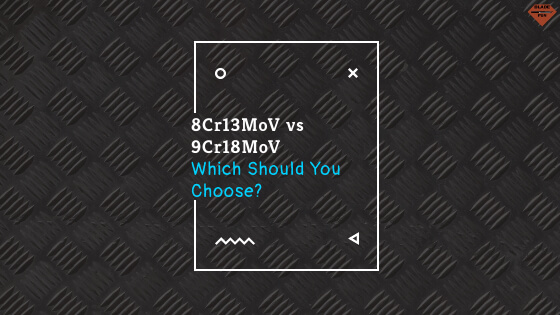So… 8Cr13MoV vs 9Cr18MoV… both extremely cryptic steel names. What do they mean? Which one’s better?
Chances are, the one with the higher numbers sounds better, but then again, maybe it’s like golf? Maybe the smaller number is better.
Let’s dive into the differences between these two steels, which one’s better, and what those cryptic names mean. If you’re just looking for which one’s better, here it is:
9Cr18MoV is better than 8Cr13MoV. It has more carbon and chromium, which means more strength and corrosion resistance, respectively. It has higher percentages of almost everything, making it an all-around step-up from 8Cr13MoV. Both are good steels for their prices, but 9Cr18MoV is better.
But, if you’d like to figure out the more cryptic names, dive into the more exact details, and overall become more versed in knives and knife steels, then let’s keep going.
The Major Differences
The major differences between the two are in their carbon and chromium content: 8Cr13MoV has about 0.8% carbon and 13% chromium; 9Cr18MoV has about 0.9% carbon and 18% chromium.
Carbon helps to increase the hardness and strength of a blade (though, too much can actually weaken a blade). So, 9Cr18MoV has more strength than 8Cr13MoV.
Chromium, the other big difference between the two, helps with corrosion resistance: The higher the percentage of chromium, the more corrosion resistance. (It’s also a soft element, so the higher the chromium, the softer the blade.) Again, 9Cr18MoV takes the cake here.
On top of that, 9Cr18MoV has higher percentages of other elements that overall make it better. Basically, 9Cr18MoV is better than 8Cr13MoV in every way–it’s the step-up.
Unfortunately, that also means that it’s got a higher price. Knives with 8Cr13MoV are usually $20-30 (depending on the design, company, other functionalities/features, etc.), while 9Cr18MoV knives are usually around the $40 mark.
It’s important to note that, while these are the general trends of the steels, things are almost bound to be different in real life. The performance of the steel can be affected by things like the heat treat, maintenance, edge geometry, and even which batch it was made in. Generally, if you go with a reputable company, you won’t have to worry too much about whether the blade will perform, though. If the company made poor knives, they likely wouldn’t be in business for too long.
8Cr13MoV
Now, let’s dive into the more exact percentages and differences between the two.
8Cr13MoV is just one of many steels with the same general name (in case you couldn’t tell already)–though, it is the first in the series. The series of steel originated from China and the name of the steel refers to its composition.
The first number (8 in this case) refers to the percentage of carbon (0.8% in this case). The “Cr” refers to chromium and the number that follows refers to the percentage of chromium in the blade (13% in this case). The “Mo” stands for molybdenum, an element that helps to improve the hardenability of the blade (basically meaning it helps to make the blade more consistent). The “V’ stands for vanadium, an element that helps to improve the strength and wearability of the blade.
In terms of the exact composition, here are the general numbers (again, this will differ in real life from blade to blade, batch to batch, etc.):
- 0.8% carbon
- 13% chromium
- 0.3% molybdenum
- 0.25% vanadium
- 1% silicon
- 1% manganese
All those components each do different things: The carbon increases strength (it’s important to note that at high levels, carbon leads to brittleness, which means easy chipping and breaking), the chromium increases corrosion resistance, the molybdenum increases hardenability (which basically means that it’s easier to harden, and thus manufacture), and vanadium improves wear resistance and strength. Manganese increases strength and hardness. Silicon does too, but to a lesser extent.
8Cr13MoV is the kind of steel you can beat up, chip, break, roll, or just plain lose without feeling too bad–the price point makes it nearly impossible to. If that’s what you’re looking for, then go with 8Cr13MoV.
9Cr18MoV
9Cr18MoV follows the same naming pattern as 8Cr13MoV. In fact, it follows 8Cr13MoV in just about everything and improves upon it.
The composition of 9Cr18MoV is about:
- 0.9% carbon
- 18% chromium
- 1.3% molybdenum
- 0.12% vanadium
- 0.8% silicon
- 0.8% manganese
Everything does the same in both blades.
Basically, 9Cr18MoV is a step-up from 8Cr13MoV. If you’re looking for a better steel (that’s still fairly budget-friendly), then 9Cr18MoV is a good option. You may feel slightly worse about losing or destroying a knife with 9Cr18MoV as opposed to 8Cr13MoV, but compared to knives that are $100+, you probably won’t feel too bad about it.
Recommended Knives
If you’re interested in some ideas for knives with 8Cr13MoV or 9Cr18MoV steels, here are some good options:
Kershaw Brawler – 8Cr13MoV
Kershaw is pretty much the king of budget knives–and 8Cr13MoV is one of the best budget steels out there. You can see where this is going…
The Kershaw Brawler (Amazon) is a snappy black folding knife with a tanto blade and the SpeedSafe assisted opening system and a flipper. It’s got 8Cr13MoV steel, a liner lock, and glass-filled nylon handles with a 4-position pocket clip. Overall, if you’re looking for a snappy assisted opening knife, you’ll enjoy this one.
Kershaw Shuffle II – 8Cr13MoV
Like I said, Kershaw is pretty much the king of budget knives. Here’s another good option for an 8Cr13MoV knife.
If you want a knife in 8Cr13MoV that doesn’t have assisted opening, then that’s where the Shuffle II (Amazon) comes in. It’s a small, lightweight multi-function knife that comes in multiple colors. It’s got a thumb stud (manual) opening, a liner lock, a bottle opener, a pry bar, and a flat-head screwdriver.
If you’re looking for something a little more low-profile (and multi-faceted), you’ll be better off with the Shuffle II than with the Brawler.
CIVIVI Praxis – 9Cr18MoV
CIVIVI is another good budget knife company. They’re a Chinese company and a subset of the WE Knife Company (another Chinese knife company).
The CIVIVI Praxis (link to Blade HQ) is a slick and smooth knife with 9Cr18MoV steel, ball bearings to make the opening nice and smooth, a flipper, ambidextrous capabilities, a deep carry pocket clip, and a liner lock (that, by the way, is colored gold). It also has a lanyard hole at the bottom of the handle and a textured G-10 handle. Overall, a good budget knife that’s pretty hard to go wrong with.
CIVIVI Chronic – 9Cr18MoV
The CIVIVI Chronic (link to Amazon) is a pretty elegant-looking knife. It’s got a flipper with a ball bearing pivot for a smooth opening, a liner lock, a deep carry pocket clip, a lanyard hole, and a textured G-10 handle. Function-wise, it’s really about the same as the Praxis, it just has a different design. So, if you’re going with one of these CIVIVIs, pick the knife design that you like.
Well, there you go. Now you’ve got the differences between 8Cr13MoV and 9Cr18MoV.
If you’re interested in learning more about blade steels, seeing more blade steel comparisons, learning about knives, and more, then we’ve got a bunch of blog posts for you. You can check them out here.

